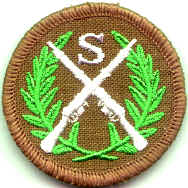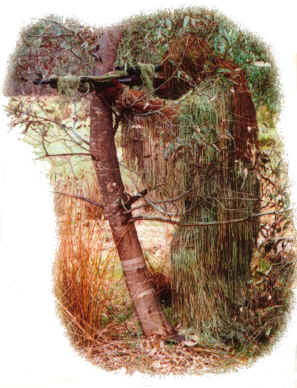|
Deadly
Assassins
Story
by Cpl Dave Bastian
of ARMY Magazine No
13 Dec 1992
Sniping,
the word conjures up images of a soldier in Hemmingway's mould , the
loner, the big game hunter, the individualist, the poacher. Through
time, snipers have been glamorised by writers and maligned by soldiers
for the way they earn their keep.
From
the soldier's point of view, he is the snake in the grass waiting for
the relaxed moment to catch his quarry unawares with a fatal
consequence. From
the book "With British Snipers to the Reich" Capt C. Shore,
wrote: "The fear and admiration which the riflemen, and their
shooting prowess roused in the breasts of the French, were made known
by Marshal Soult, Commander in Chief of the French Army in Spain, in a
letter dated 1 September 1813".
 |
Soult
stated that the loss of prominent and superior officers was so
disproportionate to that of the rank and file that he had gone
to some pains to discover the reason for so extraordinary a
circumstance.
He
wrote: "There is an English battalion of the 60th, it is
armed with a short rifle; the men are selected for their
marksmanship; they perform the duties of scouts and in action
are expressly ordered to pick off officers, especially field
or general officers".
<<<
Sleeve plate with sniper qualification
badge circa 1920. Note that the back plate went inside the
sleeve and the crown & crossed rifles were the only things
seen
"This
mode of making war and of injuring the enemy is very
detrimental to us. Our casualties in officers are so great
that after a couple of actions the whole number are usually
disabled".
|
"I
saw, yesterday, battalions whose officers had been disabled in the
ratio of one officer to eight men! I also saw battalions which were
reduced to two or three officers, although less than one sixth of
their men had been disabled."
One
of the Marshall's staff declared "Les
Rifleman killed all our officers between July 25 and August 31, viz:
500 officers and eight generals".
According
to W02 Steve King, an instructor at the School of Infantry Sniper
Cell, today's sniper teams (pair) carry out the same role.
"A
sniper's primary role is to kill selected targets on the battlefield.
That is his one and only role! Officers, commanders at any level,
signallers ... you always want to take these fellows out. "Snipers
have a limited capability to engage crew-served weapons, to put a
round into a mortar sight or a machine-gun receiver.
"There
are a number of general tasks a sniper team can fill ... to harass the
enemy or reconnaissance but if it is doing that it is not being
employed properly," W02 King explains. Historically, Australia
has never trained soldiers to fill the sniping role. Soldiers that
were good shots were given special rifles, some scoped, some
not, and tasked normally with anti-sniping duties.
In
these early days, some soldiers racked up awesome tallies. Private
William 'Billy' Sing of the 5th Light Horse (see
above) was credited officially
with 150 kills in a few months. To
be credited with a 'kill', an observer had to confirm the demise of
the target. Unofficially, Pte Sing's tally was put well above 200.
During
WW2, some Lee Enfield 3T
(T for telescope) rifles were supplied and some Diggers were
trained at unit level to fill the sniper role. In
Korea, the Malayan Emergency and later in Vietnam, Australia had no
organised sniper concept or application, the only exception
being a few Australians training with the US 25th Division in early
1970, although this was primarily a marksmanship course using US XM 21
7.62mm rifles.
Since
the early 1970s, there has been a change in perspective in sniping
with the introduction of the Sniper Cell at the School of Infantry and
the Parker Hale rifle in 1978. W02
King says there are criteria the potential sniper must fill. He has
got to be an above-average shot preferably a marksman, and have
good basic infantry skills.
"The
six-week course is very practical. We are out in the field nearly the
whole time and there are a number of disciplines the students must get
through. "Of course, there is shooting which is the main one,
navigation, stalking, observing and reporting, judging distance and
camouflage.
"He
has to be fit and I like to see a bloke who can pick things up quite
quickly. We find the 'bushies' have no problems at all," W02 King
says. "Soldiers
wearing spectacles and smokers are at a disadvantage for sure.
"The Parker Hale rifle we use at the moment is a right-handed
'gadget' and left-handers have difficulty carrying out the instant
actions and chambering rounds," W02 King adds.
 |
<<
Australian sniper qualification badge 2002
New Zealand sniper
qualification badge 2002 >>
|
 |
At
this time, the sniping rifle in
service with the Australian Army is the Parker Hale Model 82, a
bolt action repeating rifle in 7.62mm calibre. It weighs just
under 6kg, has a TX 1200 heavy barrel and is fitted with a Kahles
Helia ZF69 6x42 power telescopic sight and Number 7 reticle
(crosshair) pattern.
Parker
Hales are carried by the number one sniper in the team while the
number two sniper/observer carries a standard F88 Steyr 5.56mm rifle.
A sniper team can be tasked by the commanding officer but normally
snipers work with the 10 (intelligence officer) and the OpsO
(operations officer).
"A
pair will be deployed for a maximum of 72 hours before they are
withdrawn for a rest and to be reassigned," W02 King explains.
"Only the necessities such as ammunition, rations, radio and
optics are carried by the team to keep the load as light as possible.
"The number two will carry about 200 rounds for the Steyr while
the number one, depending on his task may only carry 30 rounds for the
Parker Hale.
|
"If
a sniper fires too many rounds he, will give his 'Possie' away
and then he will have to move to another position," W02
King says. "He is restricted in his range.
In
the book it says a sniper can get a body shot at 600m and a
head shot at 300m. "The way the Parker Hales are now,
they are so worn, that range can be taken back a bit more, but
he can provide harassing fire out to 900m."
In
the future, the Australian Defence fence Force will look at
replacing the Parker Hale with a completely new system
consisting of a rifle, sight system, uniform and target
acquisition suite.
Maj
Peter Demaine, Ammunition and Light Armament Acquisitions,
says the ADF has a requirement for a sniping system to replace
the ad-hoc arrangement based around the Parker Hale.
|
 |
"The
Parker Hale is a target rifle which does not have the ruggedness for
in-service use and it is intended the new system will contain three
sub-systems. "It will include a thermal imager, laser range
finder, rifle and sight, uniform, communications and a navigational
system. "It is likely the weapon requirement will be satisfied by
a combination of .50cal and 7.62mm rifles and an eye-safe laser
range-finder coaxially mounted with the night sight," Maj Demaine
suggests.
So
what for the future? Technology is helping the sniper put his rounds
on target and new rifles and calibres theoretically will allow body
shots to 1500m.
02 King comments that "if you look at the history books, at all
the sniping in WW 1 and WW2, blokes just had the basic kit. You got
him a rifle and he went out and killed people ...
it's pretty
straight forward.
"There
is nothing mystical about the job. It is a soldier taking his basic
infantry skills and honing them to a higher level," W02 King
stated. Author Ion Idriess wrote: "The most dangerous individual
soldier, and the world's best rifle‑shot, is the sniper". "The
sniper holds his life by his initiative, his wits, even more than by
his fearlessness. He can kill where an army cannot and he can bring
down the highest."
|